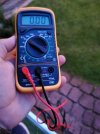Duncan, just want to give you some help with your multi-meter, I suspect you are struggling in the dark and apologies if I am stating the obvious.
As set-up in your photo, your meter will read nothing. (apologies to Dunnyrail again!)
The selector is set to DC volts 20 volts maximum. At the same time, the red lead is plugged into the 10 amp socket. This will not measure anything, you are mixing volts and amps.
Forget about using the 10 amp DC socket, I've never ever used mine, it is not helpful for fault-finding track problems with DC let alone DCC which is a special voltage and wave-form. Don't worry about understanding what DCC is, just accept it.
Your red lead should be plugged into the right-hand socket. The black lead in the socket marked COM is okay. With the leads thus connected you will be able to measure volts (DC or AC) and resistance or continuity depending where the selector is positioned.
With the selector in the 9 o'clock to 12 o'clock positions you can read DC voltage. This setting will allow you to measure the voltage of a battery, the voltage to a light bulb (in a model) or voltage to a DC motor
With the selector at the 5 o'clock position (red) you can measure simple continuity (with certain conditions ie nothing else connected) Your meter will beep when there is a circuit.
With the selector at 1 o'clock and 2 o'clock you can measure AC voltage. 600 volt range for your house wiring and 200 volt range for track power, although Greg will be horrified for me to suggest this. The actual reading shown on your meter may not be accurate but it will be a useful indication of the presence and variation of voltage around your track. I have a meter that reads track voltage of 33 volts but it was still able to be used to find voltage drops and lack of voltage.
I hope and presume that you have read Greg's excellent web pages especially ''The Clock Problem'', perhaps it is too complicated for anyone non technical, especially when (importantly) adding a load to the circuit.
Fortunately, there is an easy method to add a load. All you need is a locomotive!
So, with your multi-meter set to AC voltage, put the test-leads across the track in a problem area and watch the voltage with a locomotive running. Ideally, break the clock circle (as in Gregg's analogy) by removing pairs of track connectors. Your guide voltage is the voltage at the central station or at the track-feeds. If your voltage drops from your guide voltage then it will indicate poor track connections.
Also with the track circle broken, you could use the meter (set to continuity) to check resistance in the fish-plates although this must be done without track power and load and will not be reliable. This was Dunnyrail's suggestion earlier in the thread.
Apologies if it is stating the obvious, just trying to help.
My work ethic would be, if one fish-plate is causing problems, the remaining fish-plates will also cause a problem so I would replace the lot!
Good luck,
Alan


